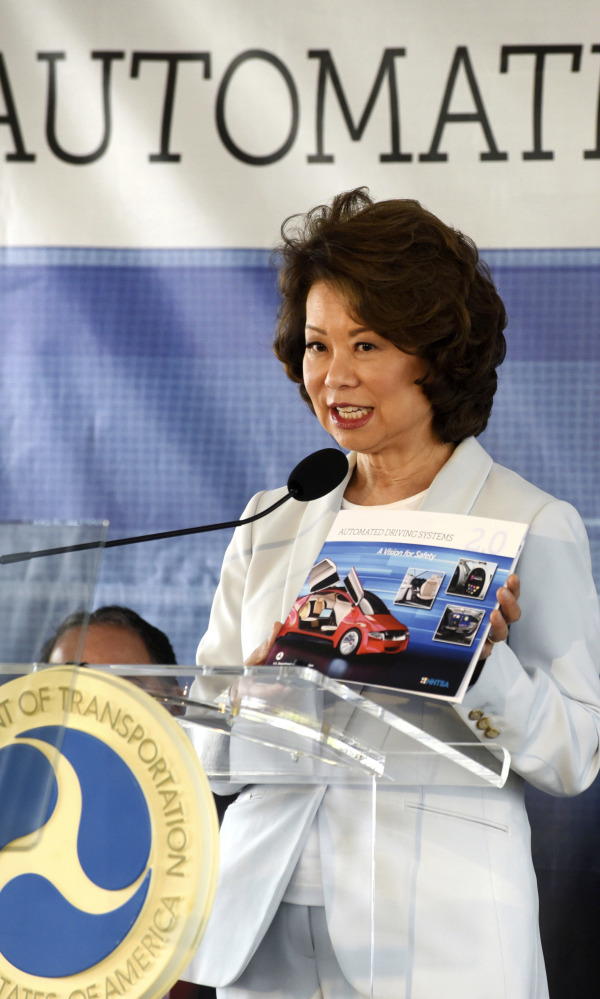ANN ARBOR, Mich. — The Trump administration on Tuesday unveiled updated safety guidelines for self-driving cars aimed at clearing barriers for automakers and tech companies wanting to get test vehicles on the road.
The new voluntary guidelines announced by U.S. Transportation Secretary Elaine Chao update policies issued last fall by the Obama administration, which were also largely voluntary.
Chao emphasized that the guidelines aren’t meant to force automakers to use certain technology or meet stringent requirements. Instead, they’re designed to clarify what vehicle developers and states should consider as more test cars reach public roads.
“We want to make sure those who are involved understand how important safety is,” Chao said during a visit to an autonomous-vehicle testing facility at the University of Michigan. “We also want to ensure that the innovation and the creativity of our country remain.”
Under the Obama administration, automakers were asked to follow a 15-point safety assessment before putting test vehicles on the road. The new guidelines reduce that to a 12-point voluntary assessment, asking automakers to consider things like cybersecurity, crash protection, how the vehicle interacts with occupants, and the backup plans if the vehicle encounters a problem. They no longer ask automakers to think about ethics or privacy issues or share information beyond crash data, as the previous guidelines did.
The guidelines also make clear that the federal government – not states – determines whether autonomous vehicles are safe. That is the same guidance the Obama administration gave.
States can still regulate autonomous vehicles, but they’re encouraged not to pass laws that would throw barriers in front of testing and use. There is nothing to prohibit California, for instance, from requiring human backup drivers on highly automated vehicles, but the National Highway Traffic Safety Administration would discourage that.
Automakers – who were growing increasingly frustrated with the patchwork of state regulations – praised the guidelines.
“You are providing a streamlined, flexible system to accommodate the development and deployment of new technologies,” Mitch Bainwol, the head of the Alliance of Automobile Manufacturers, told Chao at Tuesday’s event. The alliance represents 12 major automakers.
But critics said the guidelines don’t ensure self-driving technology is safe before going out on the road.
“NHTSA needs to be empowered to protect consumers against new hazards that may emerge, and to ensure automated systems work as they’re supposed to without placing consumers at risk,” said David Friedman, a former acting NHTSA administrator who now directs cars and product policy analysts for Consumers Union, the policy division of Consumer Reports magazine.
Regulators and lawmakers have been struggling to keep up with the pace of self-driving technology. There are no fully self-driving vehicles for sale, but autonomous cars with backup drivers are being tested in numerous states, including California, Nevada and Pennsylvania.
California, which is the only state that requires automakers to publicly report crashes of autonomous test vehicles, said Tuesday it was reviewing the new guidelines.
Chao said the federal guidelines will be updated again next year.
“The technology in this field is accelerating at a much faster pace than I think many people expected,” she said.
Chao said self-driving cars could help the blind and disabled and dramatically reduce crashes. Early estimates indicate there were more than 40,000 traffic fatalities in the U.S. last year, and an estimated 94 percent of crashes involve human error.
Since the new guidelines are policy, not law, they don’t legally change what the state and federal government and vehicle developers can do, said Bryant Walker Smith, a law professor at the University of South Carolina. Some countries, like South Korea, require pre-market government approval before autonomous vehicles can go out on the road, so the U.S. is on the more lenient side, Smith said.
Send questions/comments to the editors.



Success. Please wait for the page to reload. If the page does not reload within 5 seconds, please refresh the page.
Enter your email and password to access comments.
Hi, to comment on stories you must . This profile is in addition to your subscription and website login.
Already have a commenting profile? .
Invalid username/password.
Please check your email to confirm and complete your registration.
Only subscribers are eligible to post comments. Please subscribe or login first for digital access. Here’s why.
Use the form below to reset your password. When you've submitted your account email, we will send an email with a reset code.